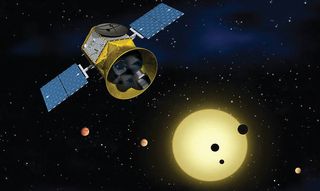
You can be a planet hunter, too.
You can help NASA's newest planet-hunting mission do its otherworldly work.
The space agency just launched a citizen-science project called Planet Patrol, which asks volunteers around the world to sort through images collected by the Transiting Exoplanet Survey Satellite (TESS).
"Automated methods of processing TESS data sometimes fail to catch imposters that look like exoplanets," Planet Patrol project leader Veselin Kostov, a research scientist at NASA's Goddard Space Flight Center in Greenbelt, Maryland, and the SETI Institute in Mountain View, California, said in a statement.
"The human eye is extremely good at spotting such imposters, and we need citizen scientists to help us distinguish between the lookalikes and genuine planets," Kostov said.
TESS launched to Earth orbit in April 2018. The spacecraft searches for alien worlds using the "transit method," noticing the tiny dips in stellar brightness caused by planets crossing their host stars' faces. But such dips can have other causes, too — natural stellar variation, for example, or a transit by a companion star.
The
TESS team uses algorithms to analyze the satellite's huge data set and
weed out false positives. But computers are far from foolproof, so the
researchers have enlisted some human help as well. Citizen scientists
have already been scrutinizing TESS "light curves" — graphs of stellar
brightness over time — through Planet Hunters TESS, a project run by the University of Oxford in England.
And now there's Planet Patrol. The new online project — a partnership involving NASA, the SETI Institute, the Space Telescope Science Institute in Baltimore and the citizen-science collaborative platform Zooniverse — asks volunteers questions about TESS images of potential exoplanets. Their answers will help mission team members to narrow down candidates for follow-up vetting.
"We're all swimming through the same sea of data, just using different strokes," Marc Kuchner, the citizen science officer for NASA's Science Mission Directorate, said in the same statement, referring to the two TESS efforts.
Though Planet Patrol currently focuses only on TESS images, the project will eventually also include light curves, if all goes according to plan, Kuchner added.
If you're interested in helping out, go to the Planet Patrol website and/or that for Planet Hunters TESS.
Mike Wall
No comments:
Post a Comment
Note: Only a member of this blog may post a comment.